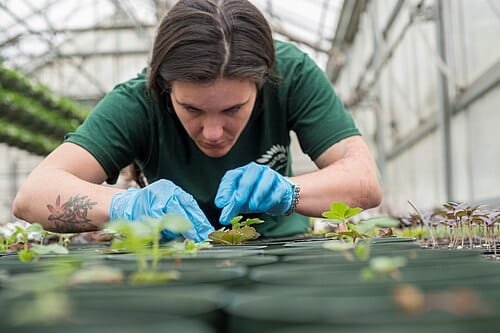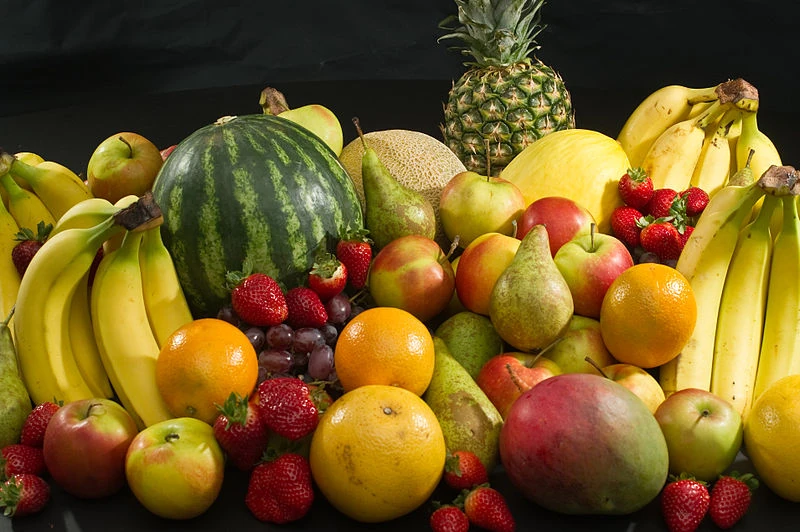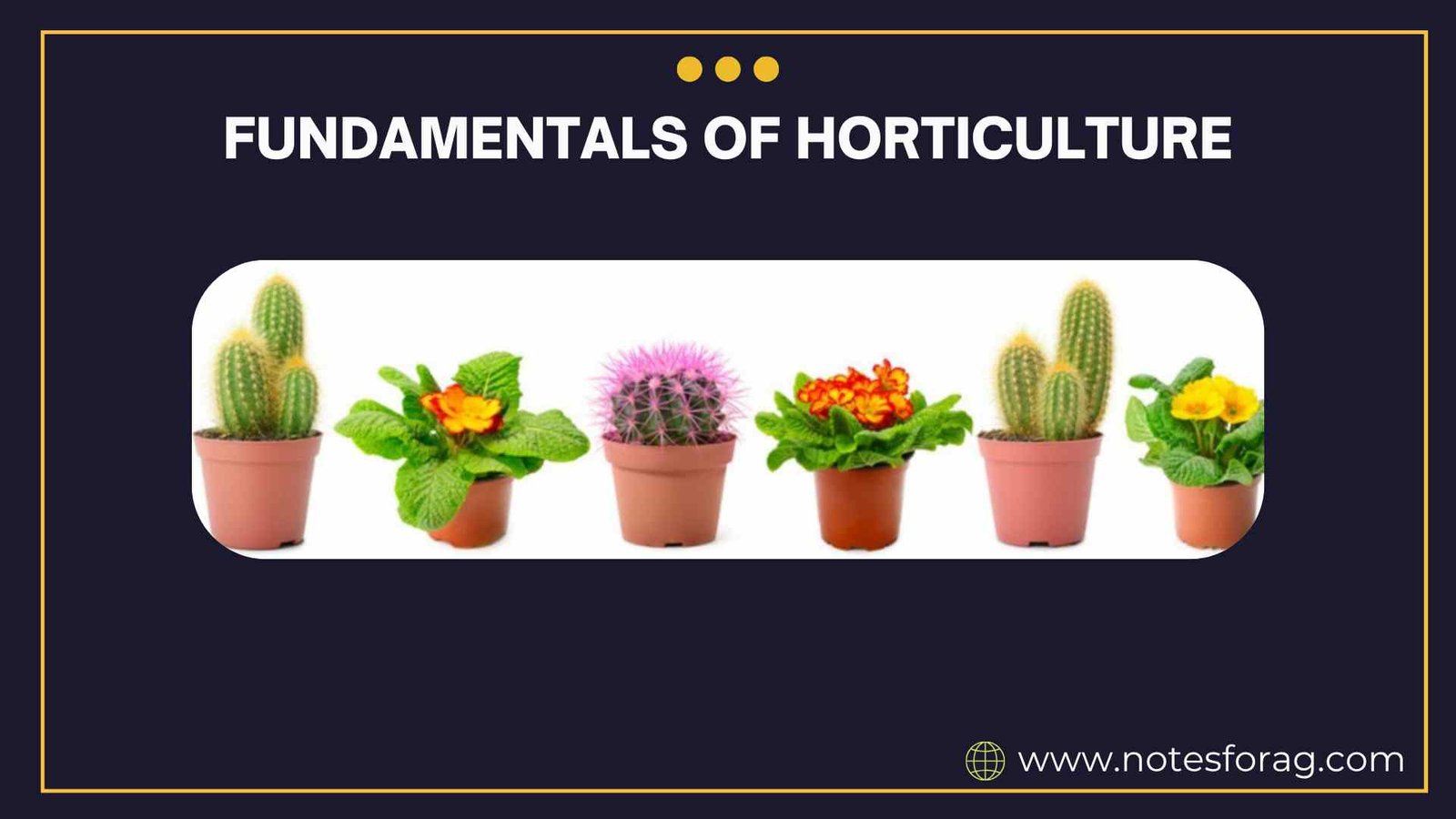Introduction to Horticulture
What is Horticulture?

Horticulture is like gardening on a professional level. It’s all about growing plants in a smart, scientific way to get the best results. While regular farming focuses on producing large amounts of crops like wheat or rice, horticulture is more about high-quality fruits, vegetables, flowers, and even designing beautiful gardens. It’s both a science (understanding how plants grow) and an art (making landscapes look stunning).
Table of Contents
Why is Horticulture Important?
Imagine a world without fresh apples, colorful flowers, or tasty tomatoes that’s what life would be like without horticulture! It gives us nutritious food, makes our cities greener, and even helps the environment by supporting bees and other pollinators. Plus, it’s a huge industry farmers, florists, and landscape designers all rely on horticulture to make a living.
Different Areas of Horticulture

Horticulture isn’t just one thing it has different branches, each with its own specialty:
- Growing fruits (like apples and oranges)
- Growing vegetables (like carrots and spinach)
- Growing flowers (like roses and sunflowers)
- Designing gardens and parks
- Keeping fruits and veggies fresh after harvest
Each of these areas uses special techniques to make sure plants grow healthy and look great.
Branches of Horticulture
The Brances of Horticulture are,
Pomology: The Science of Fruit Growing

Pomology is all about fruits how to grow them, protect them from pests, and harvest them at the right time. Farmers who grow apples, mangoes, or strawberries use pomology techniques to get the sweetest, juiciest fruits possible.
Olericulture: Vegetable Farming
This is the branch that focuses on growing vegetables. Whether it’s crunchy cucumbers or leafy lettuce, olericulture teaches farmers the best ways to plant, water, and care for veggies so they grow fast and stay healthy.
Floriculture: Flower Power
Floriculture is the art and business of growing flowers. Think of the beautiful roses in a wedding bouquet or the sunflowers in a summer garden floriculture makes sure these flowers are bright, fresh, and long-lasting.
Landscape Horticulture: Designing Green Spaces
This is where science meets creativity. Landscape horticulturists design parks, gardens, and even rooftop green spaces. They pick the right plants, arrange them beautifully, and make sure they thrive in their environment.
Post-Harvest Technology: Keeping Food Fresh
After fruits and vegetables are picked, they can spoil quickly. Post-harvest technology teaches how to store, package, and transport them so they stay fresh longer. This helps reduce food waste and keeps produce tasty when it reaches your table.
Basic Rules of Horticulture
The basic rules of Horticulture,
Picking the Right Spot for Plants
Just like people, plants have preferences some love sunlight, others prefer shade. Before planting, horticulturists study the land to make sure it has the right soil, sunlight, and climate for the plants they want to grow.
How Plants Multiply: Seeds vs. Cuttings
There are two main ways to grow new plants:
- From seeds (like planting a tomato seed)
- From cuttings (like snipping a piece of a rose plant and growing a new one)
Seeds take longer but create variety, while cuttings grow faster and stay identical to the parent plant.
Watering the Right Way
Too much water can drown plants, and too little can dry them out. Techniques like drip irrigation (slow, direct watering) and sprinklers help give plants just the right amount of water without wasting it.
Making Soil Healthy
Good soil is like a good meal for plants it needs the right mix of nutrients. Farmers add compost or fertilizer to keep the soil rich so plants grow strong.
Keeping Pests and Diseases Away
Bugs and plant diseases can ruin crops. Instead of using too many chemicals, smart horticulturists use natural predators (like ladybugs), crop rotation, and organic sprays to protect plants safely.
Conclusion
Horticulture is much more than just growing plants it’s a vital part of our daily lives, influencing the food we eat, the beauty we see in nature, and even the air we breathe. From the juicy apples in our fruit bowls to the vibrant flowers in our gardens, horticulture plays a key role in making our world healthier, more sustainable, and more enjoyable.
As the world faces challenges like climate change and food security, horticulture offers solutions. Techniques like vertical farming, hydroponics, and organic growing help produce more food with less land and water. Urban horticulture such as rooftop gardens and community farms brings fresh produce closer to cities, reducing transportation costs and carbon footprints.
Horticulture also embraces eco-friendly practices, like using natural pest control instead of harmful chemicals and recycling plant waste into compost. These methods protect the soil, conserve water, and keep ecosystems balanced.
For those interested in plants, horticulture opens doors to exciting careers whether in farming, landscaping, floral design, or agricultural research. It combines science, creativity, and problem-solving, making it a rewarding field for both professionals and hobbyists.
Horticulture is not just about growing plants it’s about growing a better future. By understanding its principles, we can make smarter choices about what we eat, how we design our surroundings, and how we protect the planet. Whether you’re a farmer, a gardener, or simply someone who enjoys fresh produce and beautiful flowers, horticulture touches your life in countless ways.
By supporting sustainable horticulture, we ensure that future generations will continue to enjoy nutritious food, green spaces, and a healthier Earth. So the next time you bite into a crisp apple or walk through a blooming garden, remember it’s all thanks to the incredible science and art of horticulture.
Frequently asked Questions (FAQs)
What is Horticulture and how is it different from agriculture?
Horticulture focuses on small-scale, high-value crop production (fruits, vegetables, flowers, and landscaping), while agriculture involves large-scale field crops like wheat or corn. Horticulture emphasizes quality, aesthetics, and sustainability .
How do I start a garden with no experience?
I can start a garden with no experience,
Pick a sunny spot (6+ hours of sunlight).
Start small (e.g., containers or a 4’x4’ raised bed).
Use quality soil (mix compost with native soil).
Water consistently (1 inch per week) .
What’s the best soil for horticulture?
The best soil for horticulture,
Loamy soil (mix of sand, silt, and clay) is ideal.
Amend with compost for nutrients.
Test soil pH (6.0–7.0 for most plants) .
Related Articles

